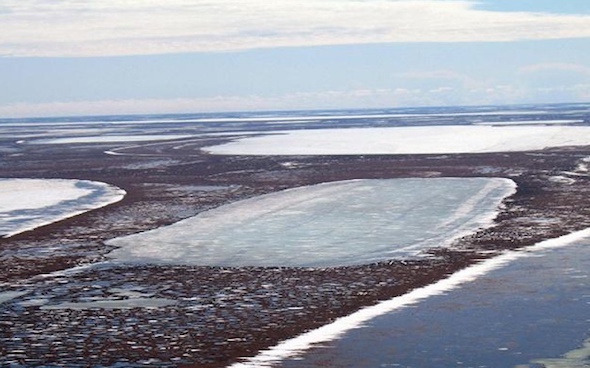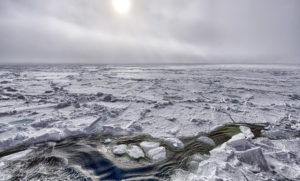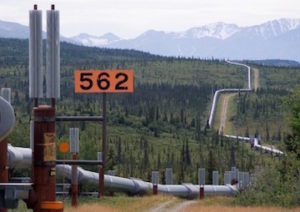The Warming Arctic Is Creating a Greenhouse Gas Danger Zone
Researchers warn that thawing soil in the Arctic tundra’s permafrost will release deadly quantities of carbon dioxide and methane into the atmosphere.
By Tim Radford / Climate News Network

Permafrost below shallow lakes such as these on Alaska’s coastal plain is thawing as a result of the changing winter climate. (Christopher Arp, University of Alaska Fairbanks)
This piece first appeared at Climate News Network.
LONDON — Climate scientists have coolly established the mechanism by which a warming Arctic will accelerate the warming of the whole world. It’s simple: as the permafrost warms and dries, it will release ever greater quantities of carbon dioxide from the Arctic soils.
And those bits of tundra that warm, thaw and become increasingly soggy will release ever greater quantities of methane, a greenhouse gas (GHG) more short-lived but also a far more potent heat trap than CO2.
The impact of the carbon dioxide, they say, could be dominant in accelerating global climate change. Since the Arctic region is already the fastest-warming place on the planet, and since the soils of the permafrost are calculated to hold twice as much carbon as is already in the atmosphere, the stakes are high — and so is the pressure on climate scientists to get the details right.
Christina Schädel, an ecosystem scientist at Northern Arizona University in the US, and 23 colleagues from New Zealand, Finland, the Czech Republic, the UK, Australia, Canada, Germany, Singapore and other US institutions report in Nature Climate Change that they made a meta-analysis of 25 separate incubation experiments with soils from the permafrost zone to establish the fine detail of what happens when long-frozen soil is warmed by 10°C.
Carbon feedback
They found that temperature and moisture both mattered — and the biggest delivery of potential greenhouse warming came with the mix of microbes, soil carbon, and oxygen.
“Our results show that increasing temperatures have a large effect on carbon release from permafrost, but that changes in soil moisture conditions have an even greater effect,” Dr Schädel says. “We conclude that the permafrost carbon feedback will be stronger when a larger percentage of the permafrost zone undergoes thaw in a dry and oxygen-rich environment.”
That a thawing Arctic could, just by the act of thawing, still further accelerate climate change is not news. Researchers have not just repeatedly confirmed the hazard but have even tried to estimate the future toll on global economies.
“A few centimetres can make the difference in whether the ground slumps and becomes wetter
or ends up high and dry.”
A report in the latest edition of Geophysical Research Letters journal says that even under the shallow lakes that dot the Arctic lowlands, permafrost is beginning to thaw.
Lakebed temperatures at a depth of a metre or less have warmed by 2.4°C during the last three decades, and for five of the last seven years, the mean annual lakebed temperature has stayed above freezing.
So warming is inexorable — and, with it, the potential release of huge quantities of long-buried carbon preserved in the peat and frozen plant material in the soils.
Question of topography
The Nature Climate Change study picks apart the fine detail of the process, and the next step is to establish whether thawing polar soils will become wetter or drier overall. This could boil down to a question of topography.
“A few centimetres can make the difference in whether the ground slumps and becomes wetter or ends up high and dry, by separating more from the water table,” says Colleen Iversen, an ecosystem scientists at the Oak Ridge National Laboratory in the US and a co-author of the report.
“There are also big ponds that might dry out over large areas, as well as soils underlain by a network of ice wedges where warming could lead to a thermokarst, or a slumping, of the land surface as permafrost thaws and the ice wedges melt.
“So the wetting and drying of the Arctic is important to observe and model at scales ranging from a metre to multiple kilometers.”
Tim Radford, a founding editor of Climate News Network, worked for The Guardian for 32 years, for most of that time as science editor. He has been covering climate change since 1988.
Your support matters…Independent journalism is under threat and overshadowed by heavily funded mainstream media.
You can help level the playing field. Become a member.
Your tax-deductible contribution keeps us digging beneath the headlines to give you thought-provoking, investigative reporting and analysis that unearths what's really happening- without compromise.
Give today to support our courageous, independent journalists.






You need to be a supporter to comment.
There are currently no responses to this article.
Be the first to respond.